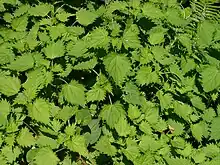| Urtica thunbergiana | |
|---|---|
 | |
| Scientific classification | |
| Kingdom: | Plantae |
| Clade: | Tracheophytes |
| Clade: | Angiosperms |
| Clade: | Eudicots |
| Clade: | Rosids |
| Order: | Rosales |
| Family: | Urticaceae |
| Genus: | Urtica |
| Species: | U. thunbergiana |
| Binomial name | |
| Urtica thunbergiana | |
Urtica thunbergiana, also known as the Japanese nettle or hairy nettle, is a species of perennial herbs in the family Urticaceae.[1][2] It is found in Japan, China and Taiwan. The habitat of the species is moist forests in the mountains. It is in flower from July to September, and its seeds ripen from August to October. The larvae of Vanessa indica, a species of butterfly, are known to feed on U. thunbergiana.
U. thunbergiana has a Chinese name commonly used in Taiwan--yǎorénmao (Traditional Chinese: 咬人貓; literally: "biting cat") – and another name commonly used in mainland China – yǎorénxúnmá (Simplified Chinese: 咬人荨麻; literally: "biting nettle"). The official name of U. thunbergiana in Taiwan is 荨麻/xúnmá,[3] and the official name in mainland China is 咬人荨麻/yǎorén xúnmá.[2] The 咬人貓/biting cat is not only a common name in Taiwan, but also a commonly used name in mainland China, according to online information. 刺草/Stinging herbs is also commonly known in China. The origin of the common name 咬人貓/biting cat is just like Dendrocnide meyeniana's common name in Chinese 咬人狗 (yǎo rén gǒu, biting-people-dog), because the stinging hairs on the plant can cause people's skin pain, redness, burning or itching.[4] Usually, the stinging sensation lasts for about 2 to 4 hours, and some people even feel the pain for 1 to 2 days, depending on the individual's constitution.[4][5]
Like some other species in Urtica, U. thunbergiana can also be used as a food ingredient, because boiling water can destroy its toxicity.[5] In Taiwan, in addition to flavored soup,[6] it is also made into flavored bread,[7] Chinese shortbread or crispy fried leaves.[5]
From 2016 to 2017, Shei-Pa National Park's headquarters commissioned a survey of animals along the Mount Dabajian hiking trail. In this investigation, a video of a Taiwan serow feeding on U. thunbergiana was recorded.[8]
_Urtica_thunbergiana_20220406201651.jpg.webp) The dotted bumps on the leaves could be cystolith?
The dotted bumps on the leaves could be cystolith?
References
- ↑ "Urtica thunbergiana 蕁麻 Urtica thunbergiana Sieb. & Zucc". 國立台灣大學生態學與演化生物學研究所. Retrieved 2022-12-06.
- 1 2 "咬人荨麻 yao ren qian ma Urtica macrorrhiza Handel-Mazzetti". Flora of China @ efloras.org. Retrieved 2022-12-06.
- ↑ "蕁麻" (in Chinese). Digital Cultures and Biodiversity Research Center, Academia Sinica, Taiwan. Retrieved 2022-12-05.
- 1 2 林育安. "有毒植物-全植株布滿有毒焮毛的咬人貓" (in Chinese). 行政院農業委員會. Retrieved 2022-12-05.
- 1 2 3 "「咬人貓」不咬人 去毒酥炸變風味野菜" (in Chinese). National Chiayi University. 31 May 2017. Retrieved 2022-12-06.
- ↑ "有毒植物系列–咬人貓" (in Chinese). Health e talk. Retrieved 2022-12-06.
- ↑ "毒刺「咬人貓」 高溫水煮製麵包可食" (in Chinese). TVBS新聞網. Retrieved 2022-12-06.
- ↑ "台灣野山羊大啖咬人貓 珍貴影像紀錄曝光" (in Chinese). Environmental Information Center. Retrieved 2022-12-06.